
Overland Tech and Travel
Advice from the world's
most experienced overlanders
tests, reviews, opinion, and more
The Audience Phenomenon

I was chatting with someone after one of my tool kit demonstrations at the 2013 Overland Expo, and he asked if I ever experienced the “audience phenomenon.” After he explained I laughed and said I certainly did—but not the same way most home mechanics do.
If you work on your own vehicles, you’re probably familiar with the cosmic rule that makes visitors show up out of nowhere to watch and comment or, more often, chat about subjects completely unrelated to the task, usually at just the moment when your frustration with some obstinate part or inaccessible fitting has reached a crescendo. Concentration goes out the window and progress grinds to a halt. Even if it’s someone whose company you normally enjoy, it’s a maddening interruption—and if it’s that neighbor across the street who uses binoculars to determine when he can show up and continue his theories about how the U.N. is secretly taking over the curriculum of our public schools, you’d be forgiven for musing on alternate uses for your 18-inch breaker bar.
However, Roseann and I live 40 miles from Tucson, in a spot so difficult to find that Google Maps will give you the wrong directions. Needless to say I’m not often interrupted by casual visitors.
At least, not human visitors.
We’re surrounded by fine Sonoran Desert habitat, keep several troughs filled with water around the yard, and regularly toss out generous handfulls of black oil sunflower seed. In response, the local wildlife has decided that our presence is to be considered no more troublesome than that of the lower servants in Downton Abbey. Even the resident zebra-tailed-lizards—normally skittish—don’t move out of our way, and if we happen to sleep past murky pre-dawn, we’ll awake with deer looking impatiently through the windows wanting a drink, cardinals and quail on the porch pecking forlornly at the clear plastic bin that holds the sunflower seed, and a Harris’s ground squirrel that’s learned to climb one of the porch chairs to check for movement in the cottage.
A few years ago I started collecting snapshots taken while I worked on various vehicles. The Clark's spiny lizard in the lead photo was a resident for four years. She got so used to being fed crickets that any time we came out of the house she'd run full-tilt at us, a trick that once got her underfoot of Roseann and cost her the end of a tail. It got so that if I sat on the floor to work on something she'd climb up my leg and I'd have to toss her off in order to get anything accomplished:
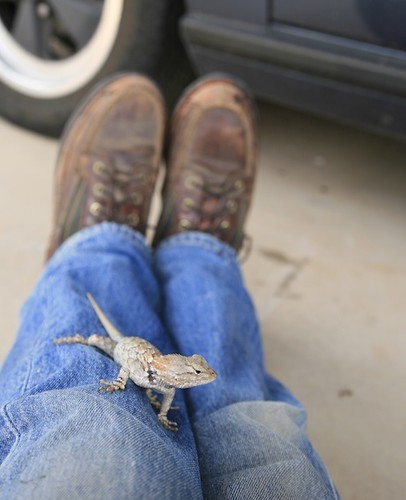
We live at 3,800 feet elevation, which is habitat for both the diminutive Coue's whitetailed deer and the larger mule deer. Ninety percent of our deer visitors are the whitetail, and multiple generations of does have taught their fawns to ignore the human fiddling about with the big shiny contraption and enjoy the water:

(Parenthetical remark: Only while compiling these photos did I notice how many were taken while I was fiddling with the British/Indian motorcycle. Just sayin' . . .)
Bucks - especially mule deer bucks - tend to be much more wary than does, at least at our place. However, one day while working on my bicycle I looked up to see a beautiful mule deer drinking from the bird bath:
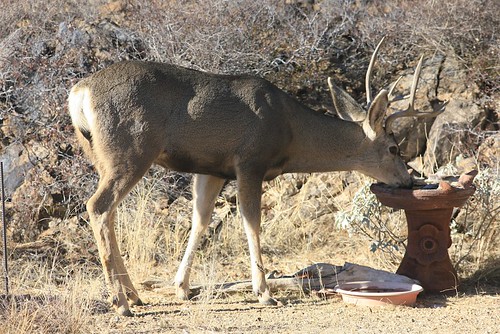
Another day while I was tracking down an electrical fault on the, uh, yeah . . . British/Indian motorcycle, I looked up to see a juvenile tortoise heading across the porch toward me. With scant regard, it continued an unerringly straight path through my tools, past me, and out the other side:
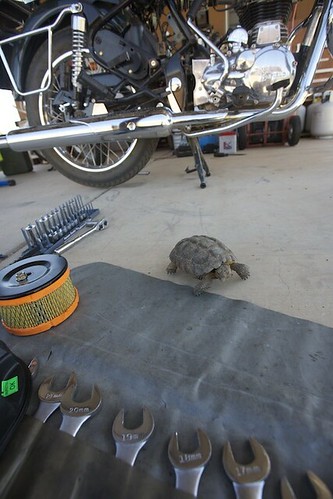
It's good that I like to start early on vehicle projects, because sleeping in is not an option around here if you're the slightest bit sensitive to that feeling of being watched:
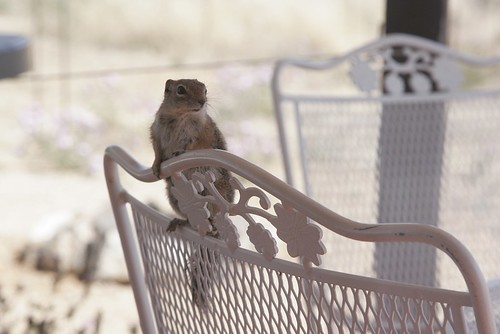
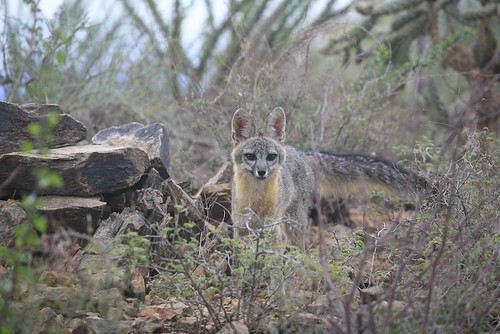
On the other hand, once you're up you need to watch where you step while doing your servant duties. Notice anything unusual in this photo?:

If you missed it, look closely in the bottom left corner:

I moved this one off a few hundred yards, but rattlesnakes are welcome residents, since they eat rodents that might otherwise wreak havoc on wiring and hoses in our vehicles. For two years I was stumped by how mice were gaining access to the trunk area of our old Porsche and setting up housekeeping:

I seriously considered dropping a diamondback into the trunk and leaving it for a week or so, but the thought of how exciting driving the car would be if I couldn't find it again dissuaded me. I finally found the mouse access point under the steering rack, and sealed it with expanding foam (don't tell the Porsche purists).
I usually try to finish up work before dark, since burning bright work lights wastes the electricity we produce through solar and wind energy, but occasionally a project will run late. Visitation drops off markedly then - at least it seems to. Some time ago our driveway security camera caught this image just a few yards from the carport:

Hey - as long as they keep quiet, the mountain lions are welcome to hang around and watch.
Historic bodge fixes: T.E. Lawrence
 T.E. Lawrence, on right, enters Damascus in the Blue Mist.
T.E. Lawrence, on right, enters Damascus in the Blue Mist.
Here’s a bit of history David Lean left out of his epic film Lawrence of Arabia: In addition to the camels T.E. Lawrence and his Bedouin allies used on their spectacular raids against Turkish outposts and railroads in what is now Saudi Arabia, Jordan, and Syria, Lawrence employed a fleet of automobiles.
An unabashed romantic, Lawrence was nevertheless also an utterly practical (and brilliant) military strategist, despite having no training whatsoever beyond the written accounts of historic campaigns he had devoured since childhood. He was the first battlefield commander to recognize and fully exploit the value of aircraft used in support of ground troops, and he pioneered aerial mapping techniques. His guerrilla tactics are still studied today by insurgents as well as counterinsurgents, yet at Tafileh in January of 1918 he proved himself equally capable of commanding a pitched conventional battle.
Lawrence also quickly realized that on the wide, flat deserts he had to cross with heavy loads of explosives and weapons, an automobile could cover ground much faster than a camel. After his stunning victory at Aqaba, he had the clout to request and receive a small detachment of armored cars, accompanied by automobile “tenders.”
But these weren’t just any automobiles. Lawrence’s desert raiding machines comprised nine Rolls Royce 40/50 Silver Ghost motorcars, including a personal vehicle he named the Blue Mist.
At the beginning of the war, Rolls Royce was already established as a maker of the finest automobiles, catering to the upper crust of society. But in those early days, such a reputation had as much to do with reliability and durability as it did luxury. In 1907 the company had entered one of its 40/50-horsepower models in the grueling Scottish Reliability Trials, and followed up the performance by driving the same car between London and Glasgow—27 times. The Autocar magazine declared it “the best car in the world”—still Rolls Royce’s motto a century later.
 A Rolls Royce 40/50 Silver Ghost in more genteel surroundings. (Image courtesy www.ritzsite.nl)
A Rolls Royce 40/50 Silver Ghost in more genteel surroundings. (Image courtesy www.ritzsite.nl)
That tremendous strength served Lawrence well in terrain and conditions far removed from what even Henry Royce had envisioned. In one passage from Seven Pillars of Wisdom Lawrence describes an exploratory excursion: “Their speedometers touched 65 mph; not bad for cars which had been months ploughing the desert with only such running repairs as the drivers had time and tools to give them.”
Alas, even the mighty Rolls Royce proved not completely immune to damage from constant, crushing abuse.
On September 16, 1917, Lawrence and a small team set out to demolish a railway bridge south of Amman, in what is now Jordan. The Blue Mist was “crammed to the gunwale” with explosives and detonators. While his companions, who had followed in another tender, engaged the Turkish post guarding the bridge in a brief but ferocious firefight, Lawrence coolly placed 150 pounds of charges in the bridge’s support spans, ignoring desperate signals from the two British officers supervising the cover fire that Turkish reinforcements were on the way. The explosion sent twisted shards of the bridge plunging into the ravine below, and further enraged the pursuing Turks.
And at that moment, as the group raced away from the rising smoke, one of the Blue Mist’s rear spring brackets snapped, dropping the body onto the tire and instantly halting forward progress. It was, as Lawrence later described it, the first and only time a Rolls let him down in the desert.
Anyone else would have simply abandoned the car, but Lawrence was loath to lose not only his faithful Blue Mist (“A Rolls in the desert was above rubies,” he wrote), but the extensive explosives kit inside. With the Turks perhaps ten minutes away, he and his driver (who was nicknamed “Rolls”) jacked up the car, and untied a length of wood plank kept with each car for deep sand recovery, with the idea of wedging it between the axle and chassis. It was too long, and “Rolls” estimated they’d need three thicknesses of the wood to support the car. They had no saw, but Lawrence solved the problem by simply shooting crosswise with his pistol through the plank several times in two places, until the board broke in three pieces. The Turks heard the firing and paused their pursuit, which lent Lawrence and “Rolls” time to rope the planks in place, using the running board as a mounting point, and make good their escape. Lawrence wrote:
“So enduring was the running board that we did the ordinary work with the car for the next three weeks, and took her so into Damascus at the end. Great was Rolls, and great was Royce! They were worth hundreds of men to us in these deserts.”
So, if you don’t already have them on board your own Rolls Royce, I suggest adding to your recovery kit one (1) wooden plank and one (1) pistol.
Hint: When using “Search,” if nothing comes up, reload the page, this usually works. Also, our “Comment” button is on strike thanks to Squarespace, which is proving to be difficult to use! Please email me with comments!
Overland Tech & Travel brings you in-depth overland equipment tests, reviews, news, travel tips, & stories from the best overlanding experts on the planet. Follow or subscribe (below) to keep up to date.
Have a question for Jonathan? Send him an email [click here].
SUBSCRIBE
CLICK HERE to subscribe to Jonathan’s email list; we send once or twice a month, usually Sunday morning for your weekend reading pleasure.
Overland Tech and Travel is curated by Jonathan Hanson, co-founder and former co-owner of the Overland Expo. Jonathan segued from a misspent youth almost directly into a misspent adulthood, cleverly sidestepping any chance of a normal career track or a secure retirement by becoming a freelance writer, working for Outside, National Geographic Adventure, and nearly two dozen other publications. He co-founded Overland Journal in 2007 and was its executive editor until 2011, when he left and sold his shares in the company. His travels encompass explorations on land and sea on six continents, by foot, bicycle, sea kayak, motorcycle, and four-wheel-drive vehicle. He has published a dozen books, several with his wife, Roseann Hanson, gaining several obscure non-cash awards along the way, and is the co-author of the fourth edition of Tom Sheppard's overlanding bible, the Vehicle-dependent Expedition Guide.



